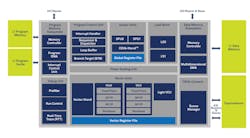More than ever, the number, and types, of sensors is proliferating rapidly in consumer products, automobiles, robotics, and emerging industrial and medical applications that are being revolutionized by initiatives such as Industry 4.0. Cameras, radar, LiDAR, time-of-flight, microphones, and inertial measurement units output a multitude of data types and bit rates derived from imaging, sound, RF, and motion. Together, these inputs can comprise a full 3D, contextually aware device or system.
The problem, of course, is amassing enough specialized processing power to flexibly, and intelligently, process and fuse all these disparate sensor outputs into data that serves all the needs of such a contextually aware system. In its new SensPro sensor-hub DSP architecture, CEVA attempts to address the need for such specialized processing in an architecture designed to handle the requisite broad range of sensor processing and fusion.
By processing and combining these sensory outputs, the SensPro architecture aims not so much to get more data from them, but rather higher quality data in complex applications such as automated driver assistance systems (ADAS), where situational awareness requires many sensors to work together to perceive and adapt to their surroundings.
Built to maximize performance-per-watt for complex multi-sensor processing use cases, the SensPro architecture combines the high-performance single- and half-precision floating-point math required for high dynamic range signal processing, point cloud creation and deep neural network (DNN) training, along with a large amount of 8- and 16-bit parallel processing capacity required for voice, imaging, DNN inference processing, and simultaneous localization and mapping (SLAM). SensPro incorporates CEVA’s CEVA-BX scalar DSP, which offers a seamless migration path from single sensory system designs to multi-sensor, contextual-aware designs.
Bridging the gap between single and multiple sensors means processing and fusing different types of data from different types of sensors. To do so, SensPro uses a highly configurable, 8-way VLIW architecture, allowing it to be easily tuned to address a wide range of applications. Its micro-architecture combines scalar and vector processing units and incorporates an advanced, deep pipeline enabling operating speeds of 1.6GHz at a 7nm process node.
SensPro incorporates a CEVA-BX2 scalar processor for control code execution with a 4.3 CoreMark/MHz score. It adopts a wide SIMD scalable processor architecture for parallel processing and is configurable for up to 1024 8x8 MACs, 256 16x16 MACs, dedicated 8x2 binary neural network support, as well as 64 single precision and 128 half precision floating point MACs. This allows it to deliver 3 TOPS for 8x8 networks inferencing, 20 TOPS for Binary Neural Networks inferencing, and 400 GFLOPS for floating-point arithmetic. Other key features of SensPro include a memory architecture providing a bandwidth of 400 GB per second, 4-way instruction cache, 2-way vector data cache, DMA, and queue and buffer managers for offloading the DSP from data transactions.
Augmenting SensPro is an advanced set of software and development tools to expedite system designs including an LLVM C/C++ compiler, Eclipse-based integrated development environment (IDE), OpenVX API, software libraries for OpenCL, CEVA deep neural network (CDNN) graph compiler including the CDNN-Invite API for inclusion of custom AI engines, CEVA-CV imaging functions, CEVA-SLAM software development kit and vision libraries, ClearVox noise reduction, WhisPro speech recognition, MotionEngine sensor fusion, and the SenslinQ software framework.
Initially, SensPro DSPs will be available in three configurations, each including a CEVA-BX2 scalar processor and various vector units configured for optimal use-case handling:
· SP250: a single-vector unit with 256 8x8 MACs targeting imaging-, vision-, and sound-centric applications
· SP500F: a single-vector unit with 512 8x8 MACs and 64 single precision floating point MACs targeting SLAM-centric applications
· SP1000: a dual-vector unit with 1024 8x8 MACs and binary networks support targeting AI-centric applications
The SensPro architecture and cores will be made available for general licensing starting in Q3 2020.
About the Author
David Maliniak
Executive Editor, Microwaves & RF
I am Executive Editor of Microwaves & RF, an all-digital publication that broadly covers all aspects of wireless communications. More particularly, we're keeping a close eye on technologies in the consumer-oriented 5G, 6G, IoT, M2M, and V2X markets, in which much of the wireless market's growth will occur in this decade and beyond. I work with a great team of editors to provide engineers, developers, and technical managers with interesting and useful articles and videos on a regular basis. Check out our free newsletters to see the latest content.
You can send press releases for new products for possible coverage on the website. I am also interested in receiving contributed articles for publishing on our website. Use our contributor's packet, in which you'll find an article template and lots more useful information on how to properly prepare content for us, and send to me along with a signed release form.
About me:
In his long career in the B2B electronics-industry media, David Maliniak has held editorial roles as both generalist and specialist. As Components Editor and, later, as Editor in Chief of EE Product News, David gained breadth of experience in covering the industry at large. In serving as EDA/Test and Measurement Technology Editor at Electronic Design, he developed deep insight into those complex areas of technology. Most recently, David worked in technical marketing communications at Teledyne LeCroy, leaving to rejoin the EOEM B2B publishing world in January 2020. David earned a B.A. in journalism at New York University.


